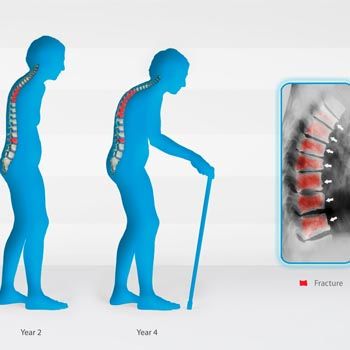What is Osteoporosis:
“Osteoporosis is a disease of bones that leads to an increased risk of fracture.” The patients of osteoporosis have thin and weak bones, which is a result of microarchitectural deterioration of bones. In osteoporosis, the bone mineral density (BMD) reduces, while the amount of proteins in bones changes from the normal range.
The word osteoporosis is derived from two Greek words, ‘osteo’ meaning bones, and ‘popos’ meaning hole or passage. According to the medical dictionary, osteoporosis is “reduction in the quantity of bone or atrophy of skeletal tissue; an age-related disorder characterized by decreased bone mass and loss of normal skeletal microarchitecture, leading to increased susceptibility to fractures."
Osteoporosis if left untreated can grow silently without causing any pain, resulting in a sudden bone fracture – most likely the hip bone, a bone in the spine, or the wrist. Hip bone fractures need immediate hospitalization and surgery, otherwise can cause walking disability and in the worst cases, even death.
The disease may be classified as primary type 1, primary type 2, or secondary. The form of osteoporosis is most common in women after menopause is referred to as primary type 1 or postmenopausal osteoporosis. Primary type 2 osteoporosis or senile osteoporosis occurs after age 75 and is seen in both females and males at a ratio of 2:1. Finally, secondary osteoporosis may arise at any age and affect men and women equally.
Symptoms of Osteoporosis:
Osteoporosis creeps up on the patient slowly and silently over the course of years, not showing up any initial or diagnosable symptoms. It might take several years when initial symptoms appear. In the early symptoms of osteoporosis, the patients complain of joint pains and difficulty in standing or sitting straight. A stooped back as seen in elderly people is a clear sign of osteoporosis.
Mostly, osteoporosis is painless even when existing from months and becomes noticeable when osteoporotic fractures occur. Osteoporotic fractures are distinguishable from the usual fractures as in the similar situations, healthy bones won’t break. They are therefore known as ‘fragility fractures’. In osteoporosis, even a cough attack or sneeze can cause ribs fracture or partial collapse of one of the spinal bones.
Risk Factors and Causes of Osteoporosis:
There can be many causes of osteoporosis, many disorders have been associated with the disease. For some, the underlying mechanism influencing the bone metabolism is straightforward, whereas for others the causes are multiple or unknown. Several factors contribute adding up to the risk of developing osteoporosis. A few are as follows,
- Women are more prone to develop osteoporosis than men. There are many reasons for that. Women naturally have a lower bone life as compared to men. The most applicable reason is of menopause which drops estrogen in women, resulting in early bone loss.
- Age is another probable factor causing osteoporosis. Bone mass naturally reduces with the passage of time.
- People with HIV are prone to develop osteoporosis.
- People with family history of osteoporosis are more likely to develop the disease with time.
- Gastric cancer patients sometimes develop osteoporosis.
- People with a lean structure or small body frame are more likely to develop osteoporosis.
- Smoking also increases the risk of developing osteoporosis.
- Eating disorders and malnutrition can be a probable cause of osteoporosis.
- Some drugs used for epilepsy, diuretics, as well as some aluminum-containing antacids also cause bone loss, resulting in osteoporosis.
Prevention and Medication:
A change in lifestyle and a few supplements can reduce the risk of getting osteoporosis. However several medications help preventing the disease. A good routine of daily walk and exercise helps preventing osteoporosis, while a balanced diet also helps.
Achieving a higher peak bone mass through exercise and proper nutrition during adolescence is important for the prevention of osteoporosis. Exercise and nutrition throughout the rest of the life delays bone degeneration. Jogging, walking, or stair climbing at 70-90% of maximum effort three times per week, along with 1,500 mg of calcium per day, increased bone density of the lumbar (lower) spine by 5% over nine months. Individuals already diagnosed with osteopenia or osteoporosis should discuss their exercise program with their physician to avoid fractures.
What osteoporosis is, what are the symptoms of osteoporosis and what can be the causes of osteoporosis? The answer to these questions is not harder to understand.



